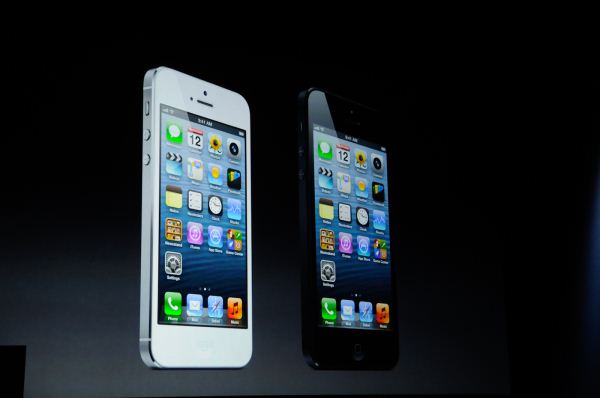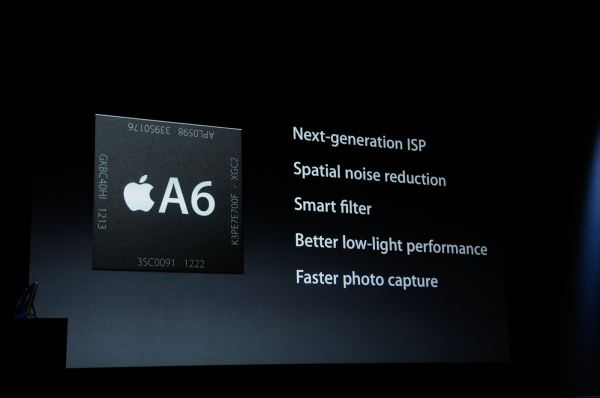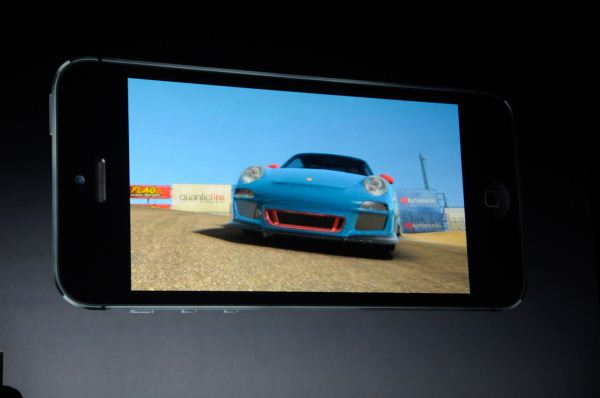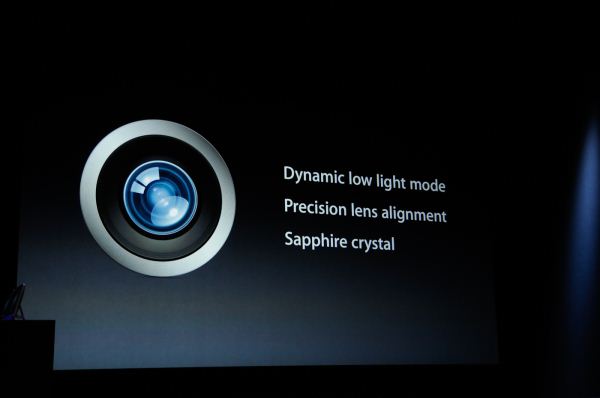Apple iPhone 5: Announced
by Anand Lal Shimpi on September 12, 2012 3:23 PM EST- Posted in
- Smartphones
- Apple
- Mobile
- iPhone 5

Apple announced its 6th generation iPhone, the iPhone 5, at a special event in San Francisco this morning. The iPhone 5 brings a huge list of improvements. Apple unexpectedly used the iPhone 5 to introduce its next-generation SoC: the A6.
Apple didn't say anything about core counts and clock speeds, but it did give us a good indication of performance: 2x faster CPU and GPU. Based on the performance gains, Apple's history of SoC naming and some other stuff we've heard recently, it looks like Apple has integrated two ARM Cortex A15 custom designed Apple ARMv7 cores on Samsung's 32nm LP HK+MG process. This is a huge deal because it means Apple beat both TI and Samsung on bringing A15s to market.
The GPU side isn't entirely clear at this point, but the 2x gains could be had through a move to 4 PowerVR SGX543 cores up from 2 in the iPhone 4S.
The new SoC is paired with Qualcomm's single-chip 28nm MDM9615 LTE baseband. Apple claims support for EDGE, EV-DO, HSPA, HSPA+, DC-HSDPA and LTE. The WiFi gets updated to dual-band 2.4GHz and 5GHz 802.11a/b/g/n, using 20MHz channels Apple can hit a peak link rate of 150Mbps over WiFi.
The display sees a big upgrade from 3.5-inches to 4-inches diagonally. The new resolution is 1136 x 640, same width but with a taller height (16:9 ratio). Legacy applications will be letterboxed until they are updated to support the added real estate. Within iOS the biggest change will be a fifth row of icons on the home screen; along with added content within apps like the calendar and Mail.
The camera saw an upgrade in silicon and software, though it seems to be the same optical package as the previous generation. Multiple stills will be integrated for better low light performance, in an all ISP solution. The package has been reduced in size by 25%, it's unclear whether that will have any effect on image quality, though. The software has been updated to included a panorama mode that yields 28MP images. Video performance on the front facing camera gets boosted to 720p and now bears that FaceTime HD moniker, while rear-facing video gets better image stabilization and face detection while shooting.
The iPhone 5 includes three mics, including support for beam forming. The ear piece also now features a noise cancelling feature. As expected there's a new dock connector: the 8-pin Lightning connector. The Lightning connector is reversible and significantly smaller than the previous 30-pin dock connector introduced in 2003.
Pricing hews to tradition, with configurations starting at 16GB and $199 and adding $100 to the price at each step up in storage (32GB and 64GB). The rest of the lineup shuffles its way down, with the iPhone 3GS being led of stage, and putting the iPhone 4S at $99 and the iPhone 4 gratis, all on contract of course. Preorders start September 14th and will be available in stores September 21st.
| Physical Comparison | |||||||
| Apple iPhone 4 | Apple iPhone 4S | Apple iPhone 5 | Samsung Galaxy S 3 | ||||
| Height | 115.2 mm (4.5") | 115.2 mm (4.5") | 123.8 mm (4.87") | 136.6 mm (5.38") | |||
| Width | 58.6 mm (2.31") | 58.6 mm (2.31") | 58.6 mm (2.31") | 70.6 mm (2.78") | |||
| Depth | 9.3 mm ( 0.37") | 9.3 mm ( 0.37") | 7.6 mm (0.30") | 8.6 mm (0.34") | |||
| Weight | 137 g (4.8 oz) | 140 g (4.9 oz) | 112 g (3.95 oz) | 133 g (4.7 oz) | |||
| CPU | Apple A4 @ ~800MHz Cortex A8 | Apple A5 @ ~800MHz Dual Core Cortex A9 | Apple A6 (Custom Apple ARM CPU) | 1.5 GHz MSM8960 Dual Core Krait | |||
| GPU | PowerVR SGX 535 | PowerVR SGX 543MP2 | PowerVR SGX 543MP3(?) | Adreno 225 | |||
| RAM | 512MB LPDDR1-400 | 512MB LPDDR2-800 | 1GB LPDDR2-1066 | 2GB LPDDR2 | |||
| NAND | 16GB or 32GB integrated | 16GB, 32GB or 64GB integrated | 16GB, 32GB or 64GB integrated | 16GB or 32GB NAND with up to 64GB microSDXC | |||
| Camera | 5MP with LED Flash + Front Facing Camera | 8MP with LED Flash + Front Facing Camera | 8MP with LED Flash + 720p Front Facing Camera | 8 MP with LED flash + 1.9 MP front facing | |||
| Screen | 3.5" 640 x 960 LED backlit LCD | 3.5" 640 x 960 LED backlit LCD | 4" 1136 x 640 LED backlit LCD | 4.8" 1280 x 720 HD Super AMOLED | |||
| Battery | Integrated 5.254Whr | Integrated 5.291Whr | Integrated ?? Whr | Removable 7.98 Whr | |||














27 Comments
View All Comments
raptorious - Wednesday, September 12, 2012 - link
Anand, the Cortex A15 is significantly larger than A9 (it's out-of-order after all). Even with the shrink to 32nm, I don't see how Apple could double graphics perf (almost always leads to roughly double the transistor count of the graphics) AND move to Cortex A15, all while making the die _22%_ smaller. Not possible.Godofmosquitos - Wednesday, September 12, 2012 - link
The A9 is also out-of-order. That's not what differentiates them.raptorious - Wednesday, September 12, 2012 - link
A9 is very limited out-of-order, not even close to the degree that A15 is.In any case, that is beside the point, A15 is a much beefier core, power and area wise.smartypnt4 - Wednesday, September 12, 2012 - link
They were unclear on the 22% figure. It could be the package or the die that has shrunk, or both. All they said was that the "chip" is 22% smaller. We won't know for a while yet. Chipworks needs to get one to tear the A6 out and analyze.However, just a shrink would lead to a 28.9% reduction in two dimensions (assuming the architecture is identical). With die sizes, the die shrink will be pretty much linear in both directions, for a difference of 50.5% total. See the iPad 2,4 review: http://www.anandtech.com/show/5789/the-ipad-24-rev...
Given that, SOMETHING got way bigger here if we're talking about a 22% smaller die. Either the GPU exploded, which is possible if they used an SGX543MP4 like the iPad 3, or the A15 cores are far larger than the A9's. I can't venture a guess on which of those is correct since we know nothing about the GPU yet.
So, basically: yes, it's entirely possible the cores are A15's. Anand wouldn't have said they were A15's unless he was sure; he doesn't make a habit of speculating on anything.
raptorious - Wednesday, September 12, 2012 - link
I looked the iPad 2,4 review just before you posted this, and given that the 32 nm A5 is about 57% the size of the 45nm, it does seem plausible that this is both dual-A15 and an upgrade to SGX543MP4.smartypnt4 - Thursday, September 13, 2012 - link
Brian just said on his twitter that he's pretty sure it's an SGX 543MP3. Which actually makes a lot of sense. Saves on die area and idle power, and you can clock the GPU higher to reach the 2x performance claim. Makes a lot of sense. I'd never thought of using a 3-core GPU. It's not that far-fetched an idea, though. Very plausible.lukarak - Wednesday, September 12, 2012 - link
2GB in an S3?Also, with the iP4 and iP4S you have the horizontal resolution first, and with the iP5 and S3 you have the vertical first?
lukarak - Wednesday, September 12, 2012 - link
NVM, that's the US one, not International which has 1 GBcspan123 - Wednesday, September 12, 2012 - link
It's a Samsung made chip. I think much much is undisputed. It's worth noting then that even Samsung hasn't yet announced (let alone shipped) a product with Cortex A-15 processors in it. The Galaxy Note II is quad core A9.In this article, it was written:
"The GPU side isn't entirely clear at this point, but the 2x gains could be had through a move to 4 PowerVR SGX543 cores up from 2 in the iPhone 4S."
Well, the same logic could be applied to a move to quad core Cortex A9s, which is exactly what the Exynos 4412 is. Apple didn't give the benchmarks used for their 2x claim and have been known to fudge things in their favor. Maybe they claim 4 cores is douple the speed of 2?
Finally, xbitlabs.com is claiming the A6 processor is "ARM Cortex-A9 cores with NEON SIMD accelerators, quad-core PowerVR SGX543MP2 graphics adapter."
Aenean144 - Wednesday, September 12, 2012 - link
Apple quoted app launch times that were 1.5 to 1.9 times faster. You don't get that with more cores. You only get that with a higher performance core or faster storage.